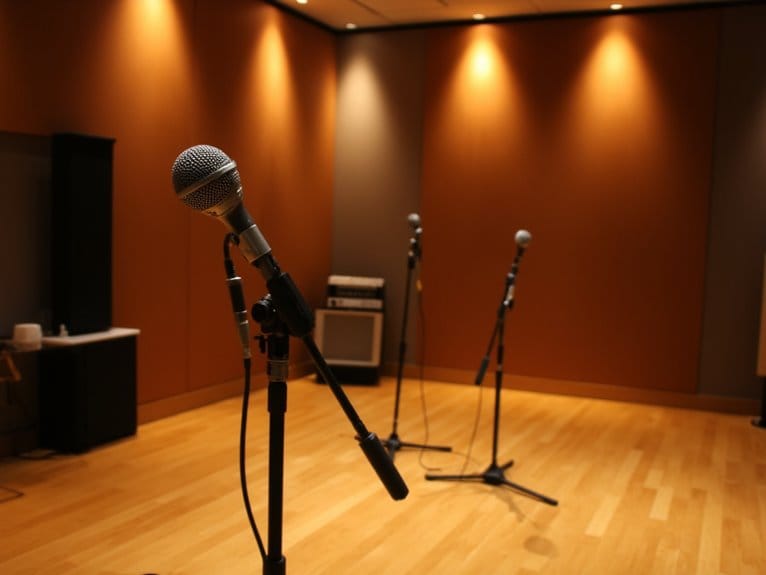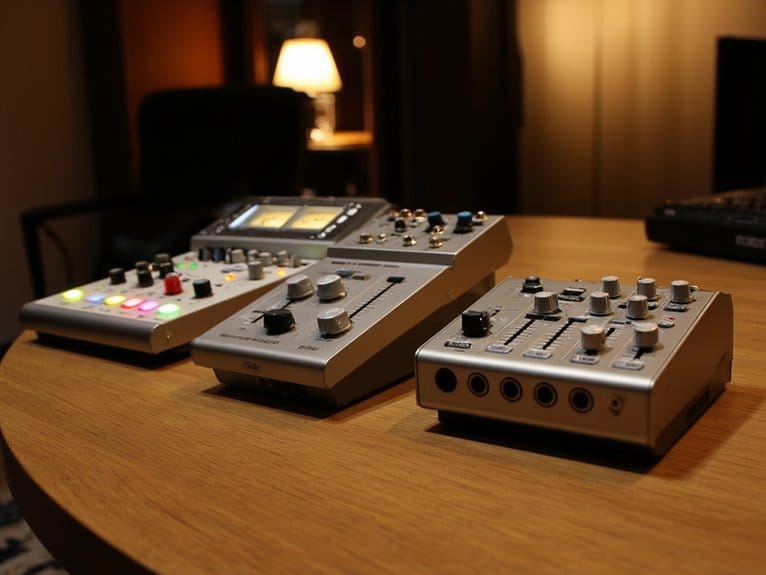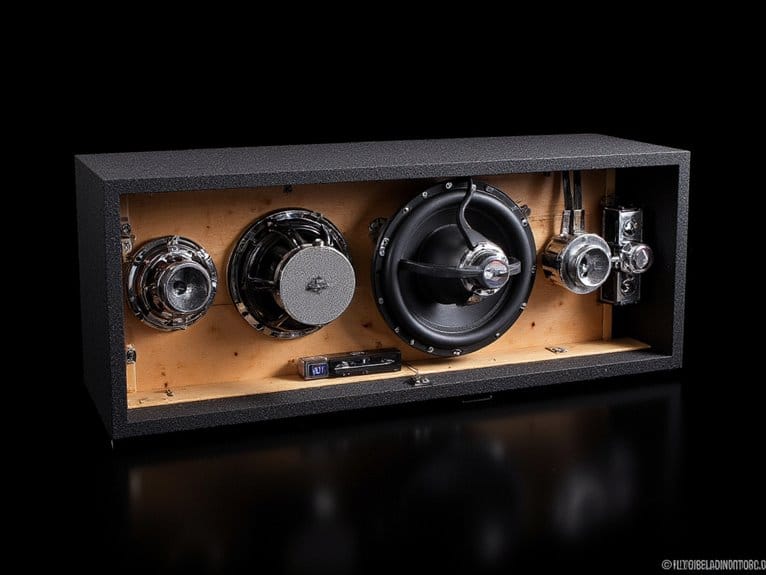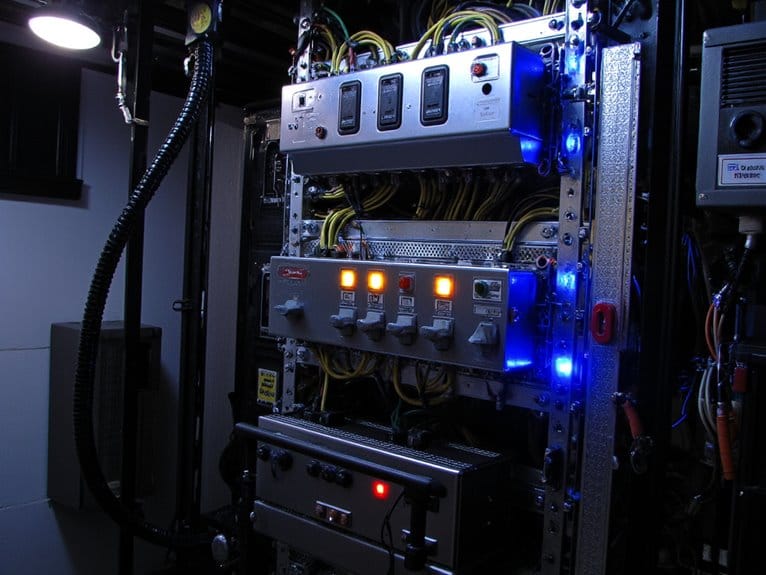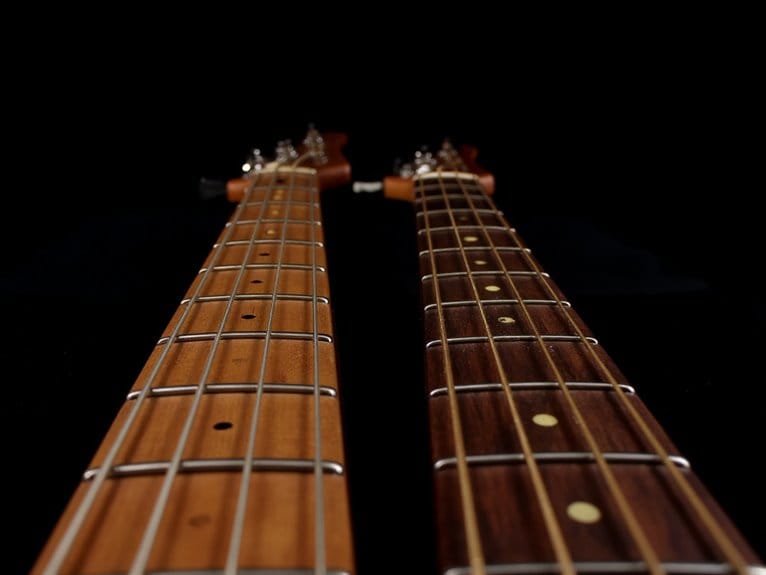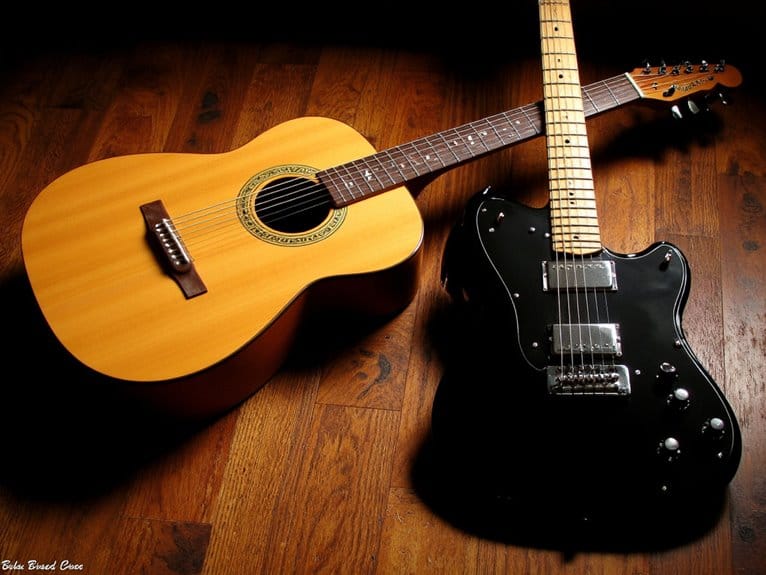Understanding the 3:1 Rule for Multiple Microphones
The 3:1 rule prevents phase interference by positioning microphones three times farther from secondary sound sources than primary ones, creating approximately 10 dB signal separation through the inverse square law. When you’re recording multiple sources, this spacing guarantees that unwanted audio reaches distant mics at considerably lower levels, reducing comb filtering effects that muddy your recordings. You’ll measure from each source to nearby mics, then place additional mics triple that distance away for ideal isolation and professional-quality capture that transforms your multi-microphone sessions.
We are supported by our audience. When you purchase through links on our site, we may earn an affiliate commission, at no extra cost for you. Learn more.
Notable Insights
- The 3:1 rule prevents phase interference by placing one microphone three times farther from the sound source than another microphone.
- This spacing exploits the inverse square law to achieve 10 dB signal separation, significantly reducing destructive comb filtering effects.
- In live settings, maintain at least three feet between backing vocalist mics and 6-9 feet spacing for overhead choir microphones.
- The rule isn’t universal—unequal sound levels and environmental factors may require spacing adjustments beyond the standard 3:1 ratio.
- Use directional microphones, measure distances precisely, and document successful setups for consistent professional audio quality across multiple recording sessions.
The Science Behind Microphone Spacing and Phase Interference
When I first started working with multiple microphones, I’ll admit I didn’t fully grasp why certain recordings sounded thin or hollow compared to single-mic setups, but the culprit was phase interference—a phenomenon that occurs when sound waves from the same source reach different microphones at slightly different times, creating destructive or constructive interference patterns that can dramatically alter your audio quality.
Think of it this way: when your microphone diaphragms move in sync, they amplify the signal, but when they’re out of phase, they cancel each other out. This sound wave interference becomes particularly problematic with specific microphone frequency ranges, where wavelengths interact differently—longer low frequencies are more forgiving than shorter high frequencies, which explains why improper spacing often results in that characteristic thin, filtered sound you’ll want to avoid. Different pickup patterns, such as supercardioid and hypercardioid, can also influence how microphones interact with each other in multi-mic setups. Complete phase cancellation occurs when frequencies reach a 180° phase difference, creating the most dramatic loss of audio content. Professional engineers rely on the 3 to 1 Rule as the standard approach to prevent this interference by ensuring microphones are positioned three times farther from each other than they are from their intended sound sources. Quality condenser microphones excel at capturing these nuanced interactions, making proper positioning even more critical for achieving professional results.
How the 3:1 Rule Minimizes Audio Bleed and Phase Cancellation
The 3:1 rule tackles these phase interference problems head-on by creating a strategic distance relationship between microphones that dramatically reduces both unwanted audio bleed and the destructive phase cancellation that plagued my early recording attempts.
The 3:1 rule creates strategic microphone spacing that eliminates phase interference and audio bleed through calculated distance relationships.
When you position microphone B three times farther from a sound source than microphone A, you’re exploiting the inverse square law to achieve approximately 10 dB of separation between the intended signal and unwanted bleed.
This level difference effectively minimizes the comb filtering effects that occur when identical sounds arrive at different mics with varying delays, regardless of mic polarities or complex sound reflections bouncing around your recording space.
The result is cleaner signal separation that maintains clarity even when mixed to mono. However, it’s important to remember that the 3:1 rule functions as a general guideline rather than an absolute requirement, and your ears should always be the final judge of sound quality during recording.
Phase interference is minimized when one mic is louder than another, creating the optimal level difference that makes the 3:1 rule effective in practice.
Real-World Applications in Studio and Live Recording Scenarios
You’ve learned the theory behind the 3:1 rule, but now it’s time to see how this fundamental principle translates into actual recording situations where I’ve watched countless engineers either nail perfect separation or struggle with muddy, phase-corrupted tracks.
Whether you’re setting up microphones in a controlled studio environment with multiple instruments, or managing the chaos of a live stage where sound bounces unpredictably off surfaces and crowds, the 3:1 rule becomes your reliable foundation for clean, professional audio capture. When multiple microphones inevitably pick up overlapping signals, comb filtering artifacts can emerge within that critical 1-25 millisecond window, turning what should be pristine recordings into frequency-mangled disasters.
I’ll walk you through specific studio recording techniques that leverage this principle for instrument isolation, then show you how live performance setups require adapted approaches to handle real-world variables like stage dimensions, ambient noise, and performer movement.
Studio Recording Techniques
Although I’ve spent countless hours explaining microphone theory, I’ll admit that studio recording is where the 3:1 rule truly proves its worth—transforming what sounds great in your head into what actually sounds great through your monitors.
When you’re implementing microphone techniques like close-miking paired with ambient capture, you’ll need that three-to-one distance ratio to maintain clarity across all channels.
I’ve watched engineers struggle with phase cancellation when recording piano using ORTF stereo configurations combined with spot mics, only to discover their isolation strategies fell apart because they ignored proper spacing.
Multi-mic setups demand individual XLR connections to separate tracks, giving you post-recording flexibility to address any phase issues that slip through, though proper initial placement following the 3:1 rule prevents most problems before they start. Each person should have their own microphone for better sound quality, as individual audio tracks simplify post-production editing and prevent crosstalk between performers. Remember that input gain adjustment remains critical during the setup process, as setting levels too high will create clipping regardless of how perfectly you’ve positioned your microphones.
Live Performance Setup
Moving from the controlled environment of the studio to live performance venues dramatically changes how you’ll implement the 3:1 rule, where factors like stage size, performer movement, and real-time sound reinforcement create challenges that can’t be solved with post-recording fixes.
Your microphone arrangement becomes vital when dealing with backing vocalists—if each singer stands one foot from their mic, you’ll need at least three feet between adjacent microphones to minimize phase cancellation. The increased distances naturally make distant sound sources quieter, which reduces their potential to interfere with the primary vocal signal.
Choir miking presents the classic scenario where this rule shines, with overhead mics typically spaced six to nine feet apart depending on performer distance from each sound source. Understanding the Inverse Square Law helps explain why this spacing effectively reduces unwanted interference between microphones while maintaining adequate signal strength from the primary sources.
Mathematical Foundation: Inverse Square Law and Signal Level Differences
When you’re positioning microphones according to the 3:1 rule, you’re actually leveraging a fundamental physics principle called the inverse square law, which dictates that sound intensity decreases proportionally to the square of the distance from its source.
I’ve found that understanding this mathematical relationship becomes essential when you realize that doubling the distance from a sound source reduces the signal level by approximately 6 decibels. Following the 3:1 spacing ratio creates roughly 10dB of separation between microphones.
This significant level difference, achieved through strategic positioning based on the inverse square law, forms the mathematical backbone that makes the 3:1 rule so effective at preventing phase cancellation and maintaining clean, interference-free recordings. Think of the sound wave as forming a sphere of acoustical energy that expands outward, where the larger the sphere becomes as it travels further from the source, the more the energy spreads across its increased surface area.
Inverse Square Law Fundamentals
The foundation of microphone placement begins with understanding the inverse square law, a fundamental acoustic principle that I’ve found governs how sound intensity decreases with distance in predictable, measurable ways.
This mathematical relationship, expressed as I ∝ 1/r², demonstrates that when you double the distance from any sound source, the intensity drops by a factor of four, which translates to a 6 dB reduction in sound pressure level.
Here’s what you need to know about this principle:
- Sound spreads spherically, distributing energy over increasingly larger surface areas as distance increases
- Every doubling of distance results in a consistent 6 dB drop in signal level
- The law assumes ideal point sources radiating uniformly in all directions
- Free-field conditions without reflections or obstructions are required for accurate predictions
- Real-world applications require adjustments for environmental factors and directional characteristics
Achieving 10dB Signal Separation
Building upon the inverse square law‘s predictable sound attenuation, I’ve discovered that achieving proper 10 dB signal separation between microphones requires precise mathematical application of distance ratios, where the spacing between mics must be at least three times the distance from each microphone to its intended source.
This mathematical relationship guarantees the unwanted source’s signal intensity drops to approximately 10% of your desired signal level, effectively minimizing crosstalk and phase cancellation issues that plague multi-microphone setups.
Different microphone types, from dynamic to condenser models, benefit equally from this spacing principle, though directional patterns can enhance separation further.
In sound reinforcement applications, I’ve found this rule particularly vital for maintaining clean channel separation without requiring extensive post-processing or complex noise reduction algorithms.
Implementation Techniques and Professional Best Practices
Once you’ve grasped the theory behind the 3:1 rule, successful implementation requires a systematic approach that I’ve refined through years of studio work, combining precise measurement techniques with practical workflow adjustments that account for real-world recording challenges.
Start by selecting appropriate microphone types with directional patterns—cardioid or hypercardioid models work best for sound isolation.
I always measure source-to-mic distances first, then position mics at three times that distance from each other. Setting ideal heights prevents unwanted reflections while maintaining the ratio.
Use tape measures or smartphone apps for accuracy, and don’t forget to test in mono. Consider investing in ultra-low-noise gain preamps to ensure your carefully positioned microphones deliver the cleanest possible signal.
Document your setup meticulously, because recreating successful configurations later will save you countless headaches during multi-session projects.
When employing multiple microphones for simultaneous recording of various sound sources, ensure compatibility between different microphone models to maintain balanced output and enhanced studio capabilities.
Frequently Asked Questions
Does the 3:1 Rule Apply to Different Microphone Pickup Patterns Like Cardioid Versus Omnidirectional?
You’ll find that the 3:1 rule applies consistently across different microphone types, whether you’re using cardioid or omnidirectional pickup patterns.
While I’ve tested various configurations, the mathematical principles behind phase cancellation remain constant regardless of directional sensitivity.
Your cardioid mics reject rear sound, and omnidirectional mics capture everything equally, but proper spacing prevents timing differences that cause comb filtering in both scenarios.
Can I Use the 3:1 Rule When Recording Instruments With Vastly Different Volume Levels?
You’ll find the 3:1 rule becomes less reliable when recording instruments with vastly different volume levels, since it assumes similar source volumes for effective bleed control.
When you’re dealing with, say, a loud drum kit next to a quiet acoustic guitar, proper mic placement requires greater spacing ratios, often 4:1 or 5:1, combined with careful volume balancing techniques to prevent the louder instrument from overwhelming your quieter source’s microphone.
How Does Room Acoustics and Reverberation Affect the Effectiveness of the 3:1 Rule?
Room acoustics considerably impact the 3:1 rule‘s effectiveness because reverberation creates additional reflections that can cause phase cancellation despite proper spacing.
In highly reflective environments, you’ll need to increase microphone distances beyond the standard 3:1 ratio since reflected sounds mask direct sound differences.
Proper room treatment and sound diffusion minimize these issues, allowing more reliable application of the rule with better source isolation.
Should I Still Follow the 3:1 Rule When Using Noise Gates or Other Processing?
Yes, you should absolutely follow the 3:1 rule even with noise gates, because proper microphone placement prevents phase cancellation at the source, while gates only reduce bleed after capture.
I’ve learned that noise gate effectiveness actually improves when you maintain proper spacing, since gates work harder and create artifacts when mics are too close together, making your processing more natural and efficient.
Does the 3:1 Rule Work for Stereo Microphone Techniques Like XY or ORTF?
No, you don’t need the 3:1 rule for XY techniques or ORTF configurations since these stereo methods use closely-spaced microphones positioned at specific angles, typically 90 degrees for XY and 110 degrees for ORTF.
Their close proximity and precise positioning inherently minimize phase issues without requiring the 3:1 distance calculation, making them naturally coherent stereo imaging techniques.
On a final note
You’ll find that mastering the 3:1 rule isn’t rocket science, though I’ve certainly made my share of phase-related mistakes over the years. When you’re positioning multiple mics, remember that this guideline works about 80% of the time, but don’t hesitate to trust your ears when the math doesn’t match reality. Your room acoustics, source material, and artistic vision should always inform your final decisions beyond any rigid formula.

